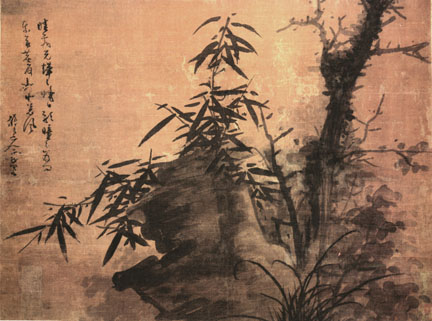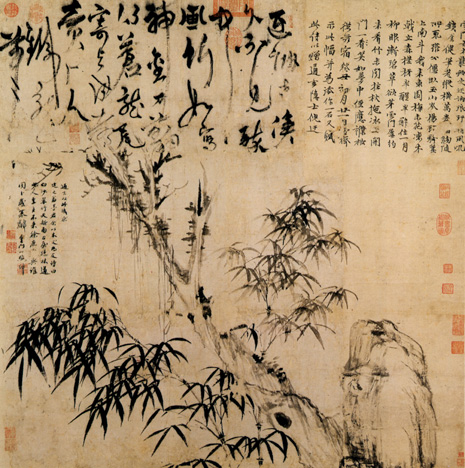Which of the Following Are Japanese Plums or Winter Plums Not Symbolic of in Chinese Art?
Orchids, ever since Qu Yuan in the Warring States Menstruation, had been associated with the virtues of the high-principled man. The orchid is delicate, small, just its fragrance penetrates into subconscious places.
 Zheng Sixiao, the painter of this moving-picture show, did the poem on the right, a friend the one on the left.
Zheng Sixiao, the painter of this moving-picture show, did the poem on the right, a friend the one on the left.
Note that in that location is no basis in this painting. When asked why he omitted it, Zheng said that the barbarians had stolen the footing.
Zheng Sixiao (1241-1318), Orchid
SOURCE: Chugoku kaiga: torokuhen , Chinese Paintings in the Osaka Municipal Museum of Fine Arts (Tokyo: Asahi Shimbun, 1975), pl. 46. Collection of the Osaka Municipal Museum of Fine Arts. Handscroll, ink on paper, 25.7 x 42.iv cm.
 The artist here has inscribed a poem on the painting that refers to the coolness and refreshing quality of the autumn melon for one who is experiencing the full rut of summertime.
The artist here has inscribed a poem on the painting that refers to the coolness and refreshing quality of the autumn melon for one who is experiencing the full rut of summertime. Because of this poem, well-educated viewers of this painting would think of literary references to melons, giving the painting deeper pregnant.
Just from looking at this painting, would y'all have guessed that it carried any larger meaning?
Qian Xuan (ca. 1235- after 1301), Autumn Melon
 This painting has all three of the "three friends of winter," pino, plum, and bamboo.
This painting has all three of the "three friends of winter," pino, plum, and bamboo.
Bamboo, considering it is flexible and tin withstand storms without breaking, is a symbol of survival in arduousness.
Zhao Mengjian (1199? - 1264 AD), Three Friends of Winter
For a closer view, click here. [In the guide, below]
What practice y'all recall pine and plum symbolize?

Zhao Mengjian (1199? - 1264 Ad), Three Friends of Winter, particular
Exercise you call back the artist left space for the inscriptions?

Wu Zhen (1280-1354), Plum and Bamboo

Wu Zhen, the painter of this rock and bamboo, was a true recluse, who rarely left his hometown and made his living by practicing fortune-telling and selling paintings.
Wu Zhen (1280-1354), Old Tree, Bamboo and Rock
 Although bamboo leaves could be painted with unmarried, calligraphic strokes, of the sort Wu Zhen used above, some literati painters as well did bamboo with outline and fill up techniques associated more than with professional person and court painters.
Although bamboo leaves could be painted with unmarried, calligraphic strokes, of the sort Wu Zhen used above, some literati painters as well did bamboo with outline and fill up techniques associated more than with professional person and court painters. Do you retrieve the mode the bamboo was painted afflicted the manner people interpreted its meaning?
Compare this bamboo painting to the ones in a higher place and below in terms of brushwork and composition.
Li Kan (1254-1320), Bamboo and Rock

Tan Zhirui (Yuan), Bamboo and Rocks

Why would scholar painters paint brightly colored flowers like peonies in different tones of ink?
Wang Qian (Yuan), Peony

This is just a small particular of a painting of a blossoming co-operative by Wang Mian. To see the entire painting, click here.
Wang Mian (1287-1359), Ink Plum

Wang Mian inscribed six poems on the painting, and four contemporaries added other poems.
How would this painting of branches of a plum tree in bloom have rated on a scale from flashy to apparently?
 Three artists collaborated to paint this painting. Gu, Zhang, and Yang did the painting together, then Ni Can, some fourth dimension after, added the rock and the inscription in the upper right.
Three artists collaborated to paint this painting. Gu, Zhang, and Yang did the painting together, then Ni Can, some fourth dimension after, added the rock and the inscription in the upper right.
Would you have been able to tell that this painting was done past several different hands?
What would artists take gotten out of collaborating to brand a single painting?
Gu An, Zhang Shen, and Ni Zan with an inscription past Yang Weizhen, Winter Bamboo and Rock |
| SOURCE: James Cahill, Ge jiang shan se - Hills Beyond a River: Chinese Painting of the Yuan Dynasty, 1279-1368, Taiwan edition (Taipei: Shitou chubanshe fen youxian gongsi, 1994), pl. 4.26, p, 200. Drove of the National Palace Museum, Taiwan. Hanging coil, ink on paper, 93.five x 52.3 cm. |
Source: https://depts.washington.edu/chinaciv/painting/tschyuan.htm
0 Response to "Which of the Following Are Japanese Plums or Winter Plums Not Symbolic of in Chinese Art?"
Post a Comment